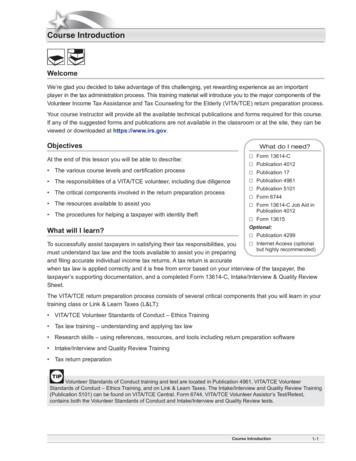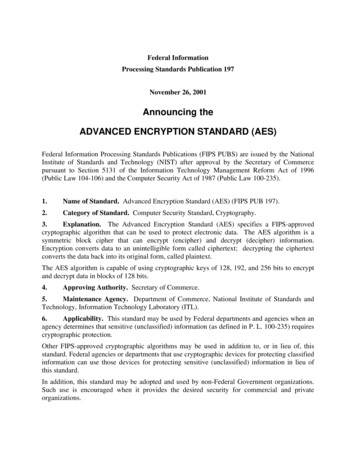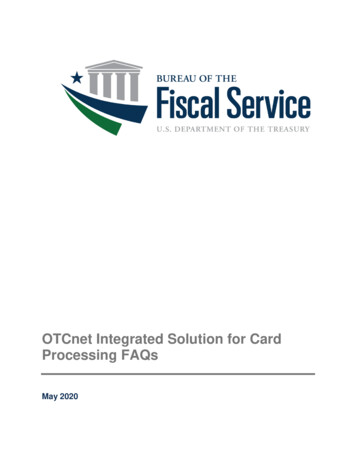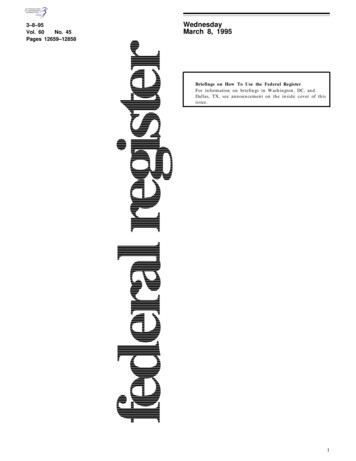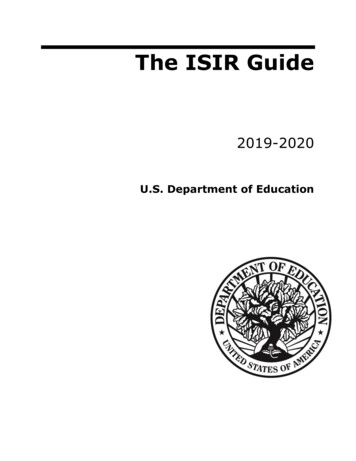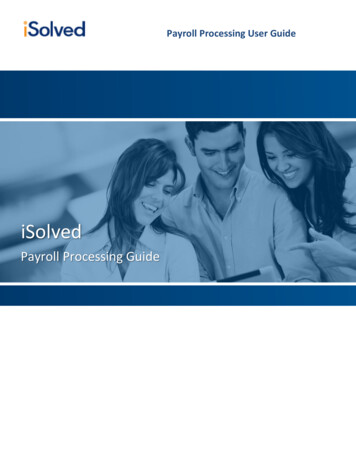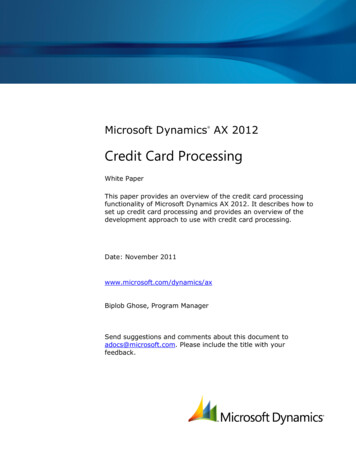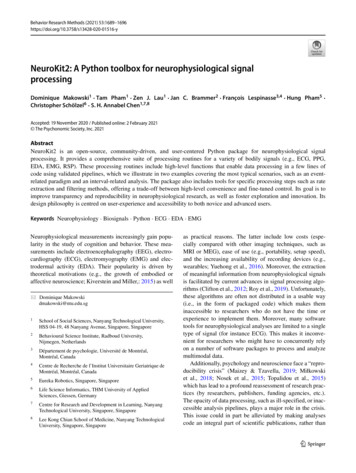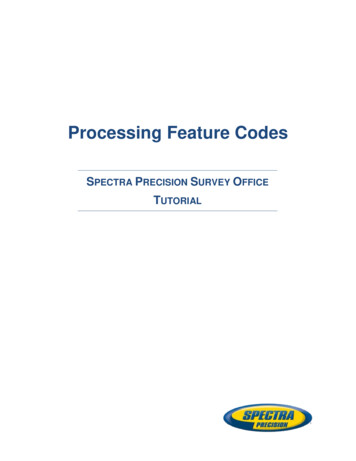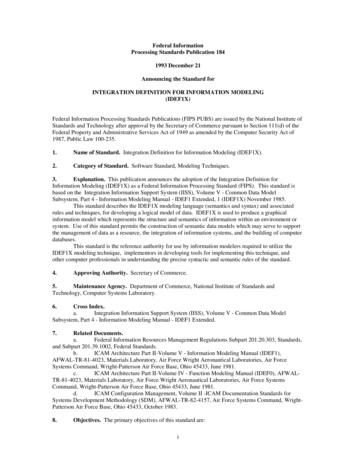
Transcription
Federal InformationProcessing Standards Publication 1841993 December 21Announcing the Standard forINTEGRATION DEFINITION FOR INFORMATION MODELING(IDEF1X)Federal Information Processing Standards Publications (FIPS PUBS) are issued by the National Institute ofStandards and Technology after approval by the Secretary of Commerce pursuant to Section 111(d) of theFederal Property and Administrative Services Act of 1949 as amended by the Computer Security Act of1987, Public Law 100-235.1.Name of Standard. Integration Definition for Information Modeling (IDEF1X).2.Category of Standard. Software Standard, Modeling Techniques.3.Explanation. This publication announces the adoption of the Integration Definition forInformation Modeling (IDEF1X) as a Federal Information Processing Standard (FIPS). This standard isbased on the Integration Information Support System (IISS), Volume V - Common Data ModelSubsystem, Part 4 - Information Modeling Manual - IDEF1 Extended, 1 (IDEF1X) November 1985.This standard describes the IDEF1X modeling language (semantics and syntax) and associatedrules and techniques, for developing a logical model of data. IDEF1X is used to produce a graphicalinformation model which represents the structure and semantics of information within an environment orsystem. Use of this standard permits the construction of semantic data models which may serve to supportthe management of data as a resource, the integration of information systems, and the building of computerdatabases.This standard is the reference authority for use by information modelers required to utilize theIDEF1X modeling technique, implementors in developing tools for implementing this technique, andother computer professionals in understanding the precise syntactic and semantic rules of the standard.4.Approving Authority. Secretary of Commerce.5.Maintenance Agency. Department of Commerce, National Institute of Standards andTechnology, Computer Systems Laboratory.6.Cross Index.a.Integration Information Support System (IISS), Volume V - Common Data ModelSubsystem, Part 4 - Information Modeling Manual - IDEF1 Extended.7.Related Documents.a.Federal Information Resources Management Regulations Subpart 201.20.303, Standards,and Subpart 201.39.1002, Federal Standards.b.ICAM Architecture Part II-Volume V - Information Modeling Manual (IDEF1),AFWAL-TR-81-4023, Materials Laboratory, Air Force Wright Aeronautical Laboratories, Air ForceSystems Command, Wright-Patterson Air Force Base, Ohio 45433, June 1981.c.ICAM Architecture Part II-Volume IV - Function Modeling Manual (IDEF0), AFWALTR-81-4023, Materials Laboratory, Air Force Wright Aeronautical Laboratories, Air Force SystemsCommand, Wright-Patterson Air Force Base, Ohio 45433, June 1981.d.ICAM Configuration Management, Volume II -ICAM Documentation Standards forSystems Development Methodology (SDM), AFWAL-TR-82-4157, Air Force Systems Command, WrightPatterson Air Force Base, Ohio 45433, October 1983.8.Objectives. The primary objectives of this standard are:i
a.To provide a means for completely understanding and analyzing an organization's data resources;b.To provide a common means of representing and communicating the complexity of data;c.To provide a technique for presenting an overall view of the data required to run an enterprise;d.To provide a means for defining an application- independent view of data which can be validatedby users and transformed into a physical database design;e.To provide a technique for deriving an integrated data definition from existing data resources.9.Applicability. An information modeling technique is used to model data in a standard, consistent,predictable manner in order to manage it as a resource.The use of this standard is strongly recommended for all projects requiring a standard means ofdefining and analyzing the data resources within an organization. Such projects include:a.incorporating a data modeling technique into a methodology;b.using a data modeling technique to manage data as a resource;c.using a data modeling technique for the integration of information systems;d.using a data modeling technique for designing computer databases.The specifications of this standard are applicable when a data modeling technique is applied to thefollowing:a.projects requiring IDEF1X as the modeling technique;b.development of automated software tools implementing the IDEF1X modeling technique.The specification of this standard are not applicable to those projects requiring data modelingtechnique other than IDEF1X.Nonstandard features of the IDEF1X technique should be used only when the needed operation orfunction cannot reasonably be implemented with the standard features alone. Although nonstandardfeatures can be very useful, it should be recognized that the use of these or any other nonstandard elementsmay make the integration of data models more difficult and costly.10.Specifications. This standard adopts the Integration Definition Method for Information Modeling(IDEF1X) as a Federal Information Processing Standard (FIPS).11.Implementation. The implementation of this standard involves two areas of consideration:acquisition of implementations and interpretation of the standard.11.1 Acquisition of IDEF1X Implementations. This publication (FIPS 184) is effective June 30,1994. Projects utilizing the IDEF1X data modeling technique, or software implementing the IDEF1X datamodeling technique, acquired for Federal use after this date should conform to FIPS 184. Conformance tothis standard should be considered whether the project utilizing the IDEF1X data modeling technique isacquired as part of an ADP system procurement, acquired by separate procurement, used under an ADPleasing arrangement, or specified for use in contracts for programming services.A transition period provides time for industry to develop products conforming to this standard.The transition period begins on the effective date and continues for one (1) year thereafter. The provisionsof this publication apply to orders placed after the date of this publication; however, utilizing an IDEF1Xinformation modeling technique that does not conform to this standard may be permitted during thetransition period.ii
11.2 Interpretation of this FIPS. NIST provides for the resolution of questions regarding theimplementation and applicability of this FIPS. All questions concerning the interpretation of IDEF1Xshould be addressed to:Director, Computer Systems LaboratoryATTN: FIPS IDEF1X InterpretationNational Institute of Standards and TechnologyGaithersburg, MD 2089912.Waivers. Under certain exceptional circumstances, the heads of Federal departments andagencies may approve waivers to Federal Information Processing Standards (FIPS). The head of suchagencies may redelegate such authority only to a senior official designated pursuant to section 3506(b) ofTitle 44, United States Code. Requests for waivers shall be granted only when:a.Compliance with a standard would adversely affect the accomplishment of the mission of anoperator of a Federal computer system, orb.Compliance with a standard would cause a major adverse financial impact on the operatorwhich is not offset by government-wide savings.Agency heads may approve requests for waivers only by a written decision which explains thebasis upon which the agency head made the required finding(s). A copy of each such decision, withprocurement sensitive or classified portions clearly identified, shall be sent to:Director, Computer Systems Laboratory,ATTN: FIPS Waiver Decisions,Technology Building, Room B-154,National Institute of Standards and Technology,Gaithersburg, MD 20899.In addition, notice of each waiver granted and each delegation of authority to approve waiversshall be sent promptly to the Committee on Government Operations of the House of Representatives andthe Committee on Government Affairs of the Senate and shall be published promptly in the FederalRegister.When the determination on a waiver request applies to the procurement of equipment and/orservices, a notice of the waiver determination must be published in the Commerce Business Daily as a partof the notice of solicitation for offers of an acquisition or, if the waiver determination is made after thatnotice is published, by amendment of such notice.A copy of the waiver request, any supporting documents, the document approving the waiverrequest and any supporting and accompanying documents, with such deletions as the agency is authorizedand decides to make under 5 U.S.C. Sec. 552 (b), shall be part of the procurement documentation andretained by the agency.13.Where to Obtain Copies. Copies of this publication are for sale by the National TechnicalInformation Service, U.S. Department of Commerce, Springfield, VA 22161. When ordering, refer toFederal Information Processing Standards Publication 184 (FIPSPUB 184) and title. Payment may bemade by check, money order, or deposit account.iii
Background:The need for semantic data models was first recognized by the U.S. Air Force in the mid-seventies as aresult of the Integrated Computer Aided Manufacturing (ICAM) Program. The objective of this programwas to increase manufacturing productivity through the systematic application of computer technology.The ICAM Program identified a need for better analysis and communication techniques for peopleinvolved in improving manufacturing productivity. As a result, the ICAM Program developed a series oftechniques known as the IDEF (ICAM Definition) Methods which included the following:a)IDEF0 used to produce a “function model” which is a structured representation of the activities orprocesses within the environment or system.b) IDEF1 used to produce an “information model” which represents the structure and semantics ofinformation within the environment or system.c)IDEF2 used to produce a “dynamics model” which represents the time varying behavioralcharacteristics of the environment or system.The initial approach to IDEF information modeling (IDEF1) was published by the ICAM program in 1981,based on current research and industry needs. The theoretical roots for this approach stemmed from theearly work of Dr. E. F. Codd on relational theory and Dr. P. P. S. Chen on the entity-relationship model.The initial IDEF1 technique was based on the work of Dr. R. R. Brown and Mr. T. L. Ramey of HughesAircraft and Mr. D. S. Coleman of D. Appleton Company, with critical review and influence by Mr. C. W.Bachman, Dr. P. P. S. Chen, Dr. M. A. Melkanoff, and Dr. G. M. Nijssen.In 1983, the U.S. Air Force initiated the Integrated Information Support System (I2S2) project under theICAM program. The objective of this project was to provide the enabling technology to logically andphysically integrate a network of heterogeneous computer hardware and software. As a result of thisproject, and industry experience, the need for an enhanced technique for information modeling wasrecognized.Application within industry had led to the development in 1982 of a Logical Database Design Technique(LDDT) by R. G. Brown of the Database Design Group. The technique was based on the relational modelof Dr. E. F. Codd, the entity-relationship model of Dr. P. P. S. Chen, and the generalization concepts of J.M. Smith and D. C. P. Smith. It provided multiple levels of models and a set of graphics for representingthe conceptual view of information within an enterprise. LDDT had a high degree of overlap with IDEF1features, introduced enhanced semantic and graphical constructs, and addressed information modelingenhancement requirements identified under the I2S2 program. Under the technical leadership of Dr. M. E.S. Loomis of D. Appleton Company, a substantial subset of LDDT was combined with the methodology ofIDEF1, and published by the ICAM program in 1985. This technique was called IDEF1 Extended or,simply, IDEF1X.A principal objective of IDEF1X is to support integration. The I2S2 approach to integration focuses on thecapture, management, and use of a single semantic definition of the data resource referred to as a“Conceptual Schema.” The “conceptual schema” provides a single integrated definition of the data withinan enterprise which is unbiased toward any single application of data and is independent of how the data isphysically stored or accessed. The primary objective of this conceptual schema is to provide a consistentdefinition of the meanings and interrelationship of data which can be used to integrate, share, and managethe integrity of data. A conceptual schema must have three important characteristics:a)It must be consistent with the infrastructure of the business and be true across all application areas.b) It must be extendible, such that, new data can be defined without altering previously defined data.c)It must be transformable to both the required user views and to a variety of data storage and accessstructures.iv
The IDEF1X approach:IDEF1X is the semantic data modeling technique described by this document. The IDEF1X technique wasdeveloped to meet the following requirements:1) Support the development of conceptual schemas.The IDEF1X syntax supports the semantic constructs necessary in the development of aconceptual schema. A fully developed IDEF1X model has the desired characteristics of beingconsistent, extensible, and transformable.2) Be a coherent language.IDEF1X has a simple, clean consistent structure with distinct semantic concepts. The syntax andsemantics of IDEF1X are relatively easy for users to grasp, yet powerful and robust.3) Be teachable.Semantic data modeling is a new concept for many IDEF1X users. Therefore, the teachability ofthe language was an important consideration. The language is designed to be taught to and usedby business professionals and system analysts as well as data administrators and databasedesigners. Thus, it can serve as an effective communication tool across interdisciplinary teams.4) Be well-tested and proven.IDEF1X is based on years of experience with predecessor techniques and has been thoroughlytested both in Air Force development projects and in private industry.5) Be automatable.IDEF1X diagrams can be generated by a variety of graphics packages. In addition, an activethree-schema dictionary has been developed by the Air Force which uses the resulting conceptualschema for an application development and transaction processing in a distributed heterogeneousenvironment. Commercial software is also available which supports the refinement, analysis, andconfiguration management of IDEF1X models.v
The basic constructs of an IDEF1X model are:1) Things about which data is kept, e.g., people, places, ideas, events, etc., represented by a box;2) Relationships between those things, represented by lines connecting the boxes; and3)Characteristics of those things represented by attribute names within the box.vi
Table of Contents1. Overview. 11.1 Scope . 11.2 Purpose . 12. Definitions . 23. IDEF1X Syntax and Semantics . 73.1 Entities. 73.1.1 Entity Semantics. 73.1.2 Entity Syntax . 83.1.3 Entity Rules . 93.2 Domains. 93.2.1 Domain Semantics. 93.2.2 Domain Syntax . 113.2.3 Domain Rules. 113.3 Views. 123.3.1 View Semantics. 123.3.2 View Syntax . 123.3.3 View Rules . 123.4 Attributes . 123.4.1 Attribute Semantics . 133.4.2 Attribute Syntax . 133.4.3 Attribute Rules . 143.5 Connection Relationships . 153.5.1 Specific Connection Relationship Semantics . 153.5.1.1 Identifying Relationship Semantics . 163.5.1.2 Non-Identifying Relationship Semantics . 163.5.2 Specific Connection Relationship Syntax . 163.5.2.1 Identifying Relationship Syntax. 173.5.2.2 Non-Identifying Relationship Syntax. 173.5.2.3 Mandatory Non-Identifying Relationship Syntax . 183.5.2.4 Optional Non-Identifying Relationship Syntax. 183.5.3 Specific Connection Relationship Label . 193.5.4 Specific Connection Relationship Rules . 203.6 Categorization Relationships . 203.6.1 Categorization Relationship Semantics . 203.6.2 Categorization Relationship Syntax . 213.6.3 Categorization Relationship Rules . 233.7 Non-Specific Relationships . 233.7.1 Non-Specific Relationship Semantics . 233.7.2 Non-Specific Relationship Syntax . 243.7.3 Non-Specific Relationship Rules . 253.8 Primary and Alternate Keys. 253.8.1 Primary and Alternate Key Semantics. 263.8.2 Primary and Alternate Key Syntax. 263.8.3 Primary and Alternate Key Rules. 273.9 Foreign Keys . 273.9.1 Foreign Key Semantics . 273.9.1.1 Role Name Semantics . 283.9.2 Foreign Key Syntax. 283.9.2.1 Role Name Syntax . 293.9.3 Foreign Key Rules. 303.10 View Levels. 313.10.1 View Level Semantics. 313.10.2 View Level Syntax . 32vii
3.10.3 View Level Rules . 323.11 View Presentation. 333.12 Glossary. 333.13 Model Notes . 343.13.1 Model Note Rules. 353.14 Lexical Conventions . 353.14.1 View, Entity, and Domain (Attribute) Names . 353.14.2 Entity Labels . 363.14.3 Role Name Attribute Labels. 363.14.4 Relationship Names and Labels . 373.14.5 Model Notes . 373.14.6 Displaying Labels on More Than One Line . 384. Bibliography . 39Annex A. Concepts and Procedures from the Original ICAM Work . 40A1. Definitions . 40A2. Data Modeling Concepts. 42A2.1 Managing Data as a Resource. 42A2.2 The Three Schema Concept. 43A2.3 Objectives of Data Modeling . 45A2.4 The IDEF1X Approach. 46A3. Modeling Guidelines. 48A3.1 Phase Zero — Project Initiation. 48A3.1.1 Establish Modeling Objectives. 48A3.1.2 Develop Modeling Plan . 49A3.1.3 Organize Team . 49A3.1.4 Collect Source Material. 54A3.1.5 Adopt Author Conventions. 55A3.2 Phase One – Entity Definition . 56A3.2.1 Identify Entities . 56A3.2.2 Define Entities . 58A3.3 Phase Two – Relationship Definition . 59A3.3.1 Identify Related Entities . 60A3.3.2 Define Relationships . 61A3.3.3 Construct Entity-Level Diagrams . 63A3.4 Phase Three - Key Definitions. 66A3.4.1 Resolve Non-Specific Relationships . 67A3.4.2 Depict Function Views . 68A3.4.3 Identify Key Attributes. 69A3.4.4 Migrate Primary Keys . 72A3.4.5 Validate Keys and Relationships . 75A3.4.6 Define Key Attributes. 80A3.4.7 Depict Phase Three Results . 81A3.5 Phase Four - Attribute Definition . 83A3.5.1 Identify Nonkey Attributes. 83A3.5.2 Establish Attribute Ownership. 83A3.5.3 Define Attributes . 85A3.5.4 Refine Model. 85A3.5.5 Depict Phase Four Results. 87viii
A4. Documentation and Validation . 89A4.1 Introduction . 89A4.2 IDEF1X Kits. 89A4.3 Standard Forms. 91A4.4 The IDEF Model Walk-Through Procedure . 96Annex B Formalization. 100B.1 Introduction . 100B.1.1 Objectives . 100B.1.2 Overview. 100B.1.2.1 An IDEF1X Theory . 100B.1.2.2 An IDEF1X Meta Model . 103B.1.3 Example . 103B.1.4.1 Diagram . 104B.1.4.2 Domains. 105B.1.3.3 Sample Instances . 106B.1.4 First Order Language . 108B.1.4.1 Truth Symbols . 108B.1.4.2 Constant Symbols . 108B.1.4.3 Variable Symbols. 109B.1.4.4 Function Symbols . 109B.1.4.5 Ter
b. using a data modeling technique to manage data as a resource; c. using a data modeling technique for the integration of information systems; d. using a data modeling technique for designing computer databases. The specifications of this standard are applicable when a data modeling technique is applied to the following: a.
